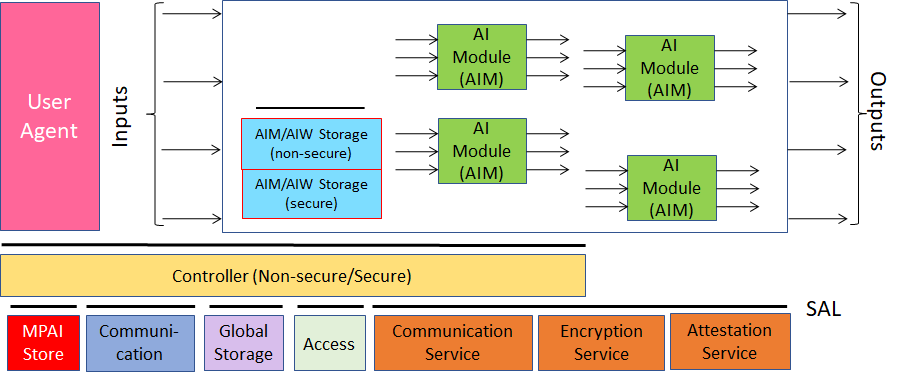(Informative)
There is a long history of computer-created objects called “digital humans”, i.e., digital objects having a human appearance when rendered. In most cases the underlying assumption of these objects has been that creation, animation, and rendering is done in a closed environment. Such digital humans had little or no need for standards.
In a communication and more so in a metaverse context, there are many cases where a digital human is not constrained within a closed environment thus requiring forms of standardisation. Technical Specification: Portable Avatar Format (MPAI-PAF) – in the following also called MPAI-PAF – is a first response to the requirements of new usage contexts. MPAI-PAF specifies a standard for Portable Avatar Format (PAF) enabling a receiving party to render a digital human as intended by the sending party.
MPAI-PAF has been developed by MPAI – Moving Picture, Audio, and Data Coding by Artificial Intelligence [11], the international, unaffiliated, non-profit organisation developing standards for Artificial Intelligence (AI)-based data coding with clear Intellectual Property Rights licensing frameworks in compliance with the rigorous MPAI Process [12] in pursuit of the following policies:
- Be friendly to the AI context but, to the extent possible, agnostic to the technology – AI or Data Processing – used in an implementation.
- Be attractive to different industries, end users, and regulators.
- Address three levels of standardisation: data types, components (called AI Modules), configurations of components (called AI Workflows) all exposing standard interfaces with an aggregation level decided by the implementer.
- Specify the data exchanged by components with a clear semantic to the extent possible.
As manager of the MPAI Ecosystem specified by Governance of MPAI Ecosystem (MPAI-GME) [1], MPAI ensures that a user can:
- Operate the reference implementation of the Technical Specification, by providing a Reference Software Specification with annexed software.
- Test the conformance of an implementation with the Technical Specification, by providing Conformance Testing Specification.
- Assess the performance of an implementation of a Technical Specification, by providing the Performance Assessment Specification.
- Get conforming implementations possibly with a performance assessment report from a trusted source through the MPAI Store.
Technical Specification: AI Framework (MPAI-AIF) V2 [2] enables an effective implementation of some of the policies. Figure 1 depicts the Reference Model.
MPAI-AIF specifies an environment called AI Framework (AIF) enabling the secure execution of AI Workflows (AIW) that can be constituted by AI Modules (AIM). Thus, users can have machines whose internal operation they understand to some degree, rather than machines that are just “black boxes” resulting from unknown training with unknown data and component developers can provide components with standard interfaces that can have improved performance compared to other implementations.

Figure 1 – The AI Framework (MPAI-AIF) V2 Reference Model
An AIW and its AIMs may have 3 interoperability levels:
- Level 1 – Implementer-specific and satisfying the MPAI-AIF Standard.
- Level 2 – Specified by an MPAI Application Standard.
- Level 3 – Specified by an MPAI Application Standard and certified by a Performance Assessor.
MPAI offers Users access to the promised benefits of AI with a guarantee of increased transparency, trust and reliability as the Interoperability Level of an Implementation moves from 1 to 3.
AI Modules can execute data processing or Artificial Intelligence algorithms and can be implemented in hardware, software, or hybrid hardware/software.
The MPAI-PAF Technical Specification can be implemented in one of the following modalities:
- As a specific AIW implementing a Use Case, as specified in this document.
- As a specific AIM, as specified in this document.
- As a specific data type, as specified in this document.
However, MPAI does not mandate the choice of modality, which remains the sole decision of the implementer.
The MPAI-PAF Technical Specification will be accompanied by the Reference Software, Conformance Testing, and Performance Assessment Specifications. Conformance Testing specifies methods enabling users to ascertain whether a data type generated by an AIM, an AIM, or an AIW conform with this Technical Specification.
The MPAI-PAF Technical Specification applies the technologies to the Avatar-Based Videoconference (PAF-ABV) Use Case where:
- Client Transmitters send PAFs containing:
- At the beginning: Avatar Models and Language Preferences.
- Continuously: Avatar Descriptors, and Speech and Face Objects to a Server.
- Avatar Videoconference Server:
- At the beginning:
- Selects an Environment, i.e., a meeting room and equips it with objects, i.e., meeting table and chairs.
- Places Avatar Models around the table.
- Distributes a PAF containing Environment, Avatar Models, and their positions to receiving clients.
- Continuously sends to receiving clients:
- Translated Speech from participants according to Language Preferences.
- Sends PAFs containing Avatar Descriptors and translated Speech.
- At the beginning:
- Client Receivers:
- At the beginning: receive Environment and PAFs containing Avatar Models and Language Preferences
- Continuously:
- Receive PAFs containing Avatar Descriptors and translated Speech.
- Create Audio and Visual Scene Descriptors.
- Render the Audio-Visual Scene as seen from the human-selected Point of View.
MPAI-PAF utilises MPAI technologies specified by other MPAI standards to specify the Avatar-Based Videoconference Use Case. Similarly, other MPAI standards utilise standard MPAI-PAF technologies in other Use Cases such as Human-Connected Autonomous Vehicle (CAV) Interaction (CAV-HCI).
Chapters, Sections, and Annexes are Normative unless they are explicitly identified as Informative.

